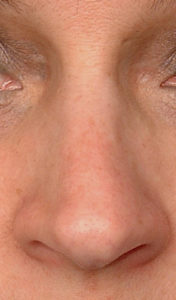
In the April 2020 issue of the Journal Plastic and Reconstructive Surgery an article was published on this topic entitled ‘A Simplified Approach to Nasal Tip Reshaping: The Five-Suture Technique’. In this paper the authors describe a five step (suture) approach to non-destructive tip reshaping. The first suture relates to the placement of a columellar strut with it being tied at the base of the columella in a horizontal mattress fashion with the knot buried between the medial crural cartilages. The key to the length and placement of the strut is that it does not contact the nasal spine and leaves some soft tissue underneath the graft for a natural recoil of the tip when smiling.
Tip projection is determined by nasal skin redrawing and trimming the graft flush with the dome at the desired amount of projection. The anterior end of the strut graft is then made more narrow than the caudal portion. Sutures #2 and #3 secure each dome to the columellar strut separately.The way these sutures are placed allows the caudal aspect of the domes to be more prominent (anteriorly projected) than the cephalic area. Suture #4 is placed across the cephalic edges and the columellar strut. The final suture #5 approximates the middle crura to the columellar strut to control the length of the infra tip lobule and columellar-lobular breakpoint.
This well thought out approach to nasal tip reshaping is to create a diamond shape which is felt to be ideal for the nasal tip. Fundamental to this technique is columellar strut graft which provides the framework for the suture tip reshaping. A key principle is that the tip defining points are created by the caudal aspect of the domes. The cephalic aspect creates the supratip break. With medialization of the cephalic margin and eversion of the caudal margin the bulbous tip is reduced and the alar rims strengthened.
This article demonstrates that all nasal tip sutures in rhinoplasty are not equal and argues against a single transdomal suture to put together the columellar strut-dome complex.
Dr. Barry Eppley
Indianapolis, Indiana



